
Construct a device to measure the height of a bounced ball, then compare the bouncing heights of various types of balls. Record the results on a chart.
- Subject:
- Mathematics
- Science
- Material Type:
- Lesson Plan
- Provider:
- PBS
- Date Added:
- 12/01/2023

Construct a device to measure the height of a bounced ball, then compare the bouncing heights of various types of balls. Record the results on a chart.

The 20th century was the first century that made use of data collection to track the American population. This interesting site provides a timeline of the century by significant events and measures of data.
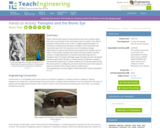
Vision is the primary sense of many animals and much is known about how vision is processed in the mammalian nervous system. One distinct property of the primary visual cortex is a highly organized pattern of sensitivity to location and orientation of objects in the visual field. But how did we learn this? An important tool is the ability to design experiments to map out the structure and response of a system such as vision. In this activity, students learn about the visual system and then conduct a model experiment to map the visual field response of a Panoptes robot. (In Greek mythology, Argus Panoptes was the "all-seeing" watchman giant with 100 eyes.) A simple activity modification enables a true black box experiment, in which students do not directly observe how the visual system is configured, and must match the input to the output in order to reconstruct the unseen system inside the box.

Counting and cardinality, measurement, and measureable attributes are all discovered in this activity from Peg + Cat. Your child can earn badges as they complete a morning routine with Peg and her best friend Cat.

This video geometry lesson [6:14] explains the concept of perimeter and has varied exercises for students to practice.

An interactive simulation that teaches about springs, Hooke's Law, and conservation of energy observing changes in kinetic, potential, and thermal energy by adjusting the stiffness and damping of springs holding various masses. This simulation can either be downloaded or played online and includes handouts, lesson plans, and additional materials.
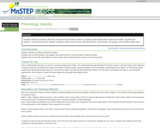
Students will raise questions about the natural world and seek answers by making careful observations about the weather. Students will measure, record and describe weather conditions using common tools, like thermometer, anemometer, rain gauge and possibly, light meter.

Students learn about population density within environments and ecosystems. They determine the density of a population and think about why population density and distribution information is useful to engineers for city planning and design as well as for resource allocation.

Word problems are provided for practice with area & perimeter of rectangles. Immediate feedback is given and hints or a video are available if needed.
Khan Academy learning modules include a Community space where users can ask questions and seek help from community members. Educators should consult with their Technology administrators to determine the use of Khan Academy learning modules in their classroom. Please review materials from external sites before sharing with students.

These weekly activities are cross-curricular but emphasize Social-Emotional Learning, Math, and Literacy development. This week (January 4th), we are working on problem-solving.m

Learn about the dynamic relationships between a jet engine's heat loss, surface area, and volume in this video adapted from Annenberg Learner's Learning Math: Patterns, Functions, and Algebra.
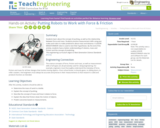
Students learn about the concept of pushing, as well as the relationship between force and mass. Students practice measurement skills using pan scales and rulers to make predictions about mass and distance. A LEGO MINDSTORMS(TM) NXT robot is used to test their hypotheses. By the end of the activity, students have a better understanding of robotics, mass and friction and the concept of predicting.

In this video from Cyberchase, the CyberSquad figures out how fast their broom must go so they can reach Motherboard before Wicked.

In this video segment from Cyberchase, the CyberSquad learns how to read a thermometer as they try to keep their chocolate sculpture from melting.
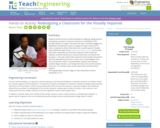
Students practice human-centered design by imagining, designing and prototyping a product to improve classroom accessibility for the visually impaired. To begin, they wear low-vision simulation goggles (or blindfolds) and walk with canes to navigate through a classroom in order to experience what it feels like to be visually impaired. Student teams follow the steps of the engineering design process to formulate their ideas, draw them by hand and using free, online Tinkercad software, and then 3D-print (or construct with foam core board and hot glue) a 1:20-scale model of the classroom that includes the product idea and selected furniture items. Teams use a morphological chart and an evaluation matrix to quantitatively compare and evaluate possible design solutions, narrowing their ideas into one final solution to pursue. To conclude, teams make posters that summarize their projects.

This interactive activity adapted from the Wisconsin Online Resource Center challenges you to plan, measure, and calculate the correct amount of roofing material needed to reroof a house.

Predict the correct amount of roofing material needed to reroof a house while learning about the importance of proper planning.
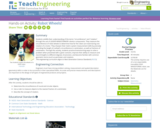
Students solidify their understanding of the terms "circumference" and "rotation" through the use of LEGO MINDSTORMS(TM) NXT robotics components. They measure the circumference of robot wheels to determine how far the robot can travel during one rotation of an NXT motor. They sharpen their metric system measurement skills by precisely recording the length of a wheel's circumference in centimeters, as well as fractions of centimeters. Through this activity, students practice brainstorming ways to solve a problem when presented with a given scenario, improve their ability to measure and record lengths to different degrees of precision, and become familiar with common geometric terms (such as perimeter and rotation).

This site provides great practice on the concept of volume. Students can first learn about the topic by watching a step by step instruction video that also points out areas of concern. Finally, students can practice their knowledge by taking a quiz.

This DragonflyTV segment introduces NASA roboticist Dr. Ayanna Howard. Her job is to use artificial intelligence (AI) to build robots that can travel into space and other hazardous locations. In this segment, she discusses her work on a rover for use on Mars. Also available in Spanish. [2:07]